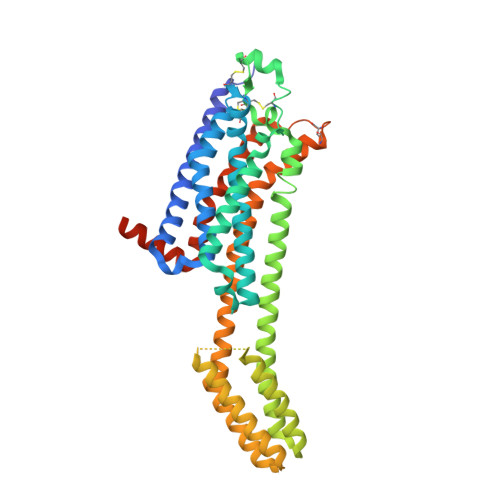Allosteric Coupling of Drug Binding and Intracellular Signaling in the A2A Adenosine Receptor.
Eddy, M.T., Lee, M.Y., Gao, Z.G., White, K.L., Didenko, T., Horst, R., Audet, M., Stanczak, P., McClary, K.M., Han, G.W., Jacobson, K.A., Stevens, R.C., Wuthrich, K.(2018) Cell 172: 68-80.e12
- PubMed: 29290469
- DOI: https://doi.org/10.1016/j.cell.2017.12.004
- Primary Citation of Related Structures:
6AQF - PubMed Abstract:
Signaling across cellular membranes, the 826 human G protein-coupled receptors (GPCRs) govern a wide range of vital physiological processes, making GPCRs prominent drug targets. X-ray crystallography provided GPCR molecular architectures, which also revealed the need for additional structural dynamics data to support drug development. Here, nuclear magnetic resonance (NMR) spectroscopy with the wild-type-like A 2A adenosine receptor (A 2A AR) in solution provides a comprehensive characterization of signaling-related structural dynamics. All six tryptophan indole and eight glycine backbone 15 N- 1 H NMR signals in A 2A AR were individually assigned. These NMR probes provided insight into the role of Asp52 2.50 as an allosteric link between the orthosteric drug binding site and the intracellular signaling surface, revealing strong interactions with the toggle switch Trp 246 6.48 , and delineated the structural response to variable efficacy of bound drugs across A 2A AR. The present data support GPCR signaling based on dynamic interactions between two semi-independent subdomains connected by an allosteric switch at Asp52 2.50 .
- Department of Integrative Structural and Computational Biology, The Scripps Research Institute, La Jolla, CA 92037, USA; Departments of Biological Sciences and Chemistry, Bridge Institute, University of Southern California, Los Angeles, CA 90089, USA.
Organizational Affiliation:





















